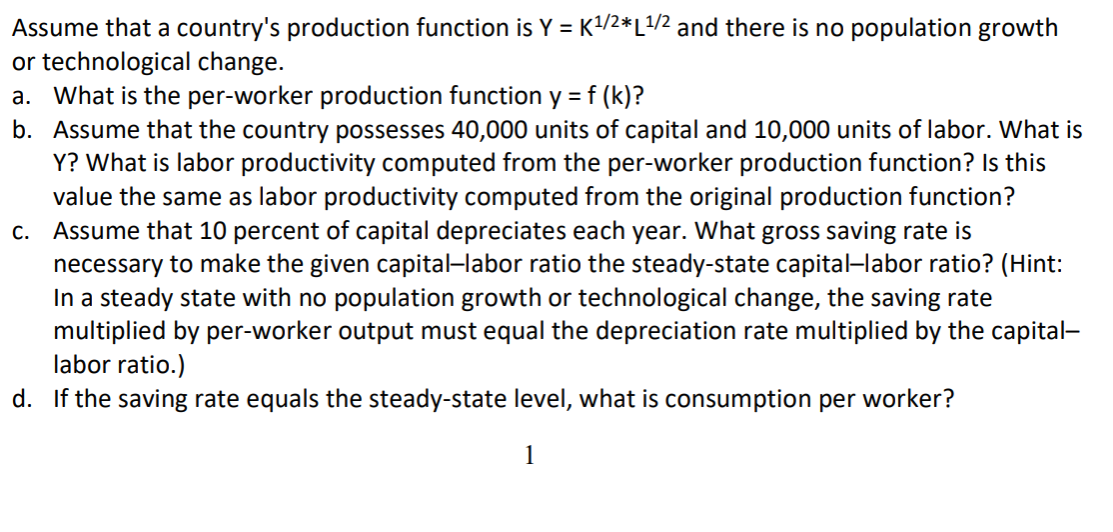Assume that a country's production function is Y = K/2*L/2 and there is no population growth or technological change. a. What is the per-worker production function y = f (k)? b. Assume that the country possesses 40,000 units of capital and 10,000 units of labor. What is Y? What is labor productivity computed from the per-worker production function? Is this value the same as labor productivity computed from the original production function? c. Assume that 10 percent of capital depreciates each year. What gross saving rate is necessary to make the given capital-labor ratio the steady-state capital-labor ratio? (Hint: In a steady state with no population growth or technological change, the saving rate multiplied by per-worker output must equal the depreciation rate multiplied by the capital- labor ratio.)
Assume that a country's production function is Y = K/2*L/2 and there is no population growth or technological change. a. What is the per-worker production function y = f (k)? b. Assume that the country possesses 40,000 units of capital and 10,000 units of labor. What is Y? What is labor productivity computed from the per-worker production function? Is this value the same as labor productivity computed from the original production function? c. Assume that 10 percent of capital depreciates each year. What gross saving rate is necessary to make the given capital-labor ratio the steady-state capital-labor ratio? (Hint: In a steady state with no population growth or technological change, the saving rate multiplied by per-worker output must equal the depreciation rate multiplied by the capital- labor ratio.)
Chapter20: Economic Growth In The Global Economy
Section: Chapter Questions
Problem 5P
Related questions
Question

Transcribed Image Text:Assume that a country's production function is Y = K/2*L/2 and there is no population growth
or technological change.
a. What is the per-worker production function y = f (k)?
b. Assume that the country possesses 40,000 units of capital and 10,000 units of labor. What is
Y? What is labor productivity computed from the per-worker production function? Is this
value the same as labor productivity computed from the original production function?
c. Assume that 10 percent of capital depreciates each year. What gross saving rate is
necessary to make the given capital-labor ratio the steady-state capital-labor ratio? (Hint:
In a steady state with no population growth or technological change, the saving rate
multiplied by per-worker output must equal the depreciation rate multiplied by the capital-
labor ratio.)
Expert Solution
This question has been solved!
Explore an expertly crafted, step-by-step solution for a thorough understanding of key concepts.
This is a popular solution!
Trending now
This is a popular solution!
Step by step
Solved in 5 steps

Knowledge Booster
Learn more about
Need a deep-dive on the concept behind this application? Look no further. Learn more about this topic, economics and related others by exploring similar questions and additional content below.Recommended textbooks for you

Exploring Economics
Economics
ISBN:
9781544336329
Author:
Robert L. Sexton
Publisher:
SAGE Publications, Inc

Essentials of Economics (MindTap Course List)
Economics
ISBN:
9781337091992
Author:
N. Gregory Mankiw
Publisher:
Cengage Learning

Brief Principles of Macroeconomics (MindTap Cours…
Economics
ISBN:
9781337091985
Author:
N. Gregory Mankiw
Publisher:
Cengage Learning

Exploring Economics
Economics
ISBN:
9781544336329
Author:
Robert L. Sexton
Publisher:
SAGE Publications, Inc

Essentials of Economics (MindTap Course List)
Economics
ISBN:
9781337091992
Author:
N. Gregory Mankiw
Publisher:
Cengage Learning

Brief Principles of Macroeconomics (MindTap Cours…
Economics
ISBN:
9781337091985
Author:
N. Gregory Mankiw
Publisher:
Cengage Learning